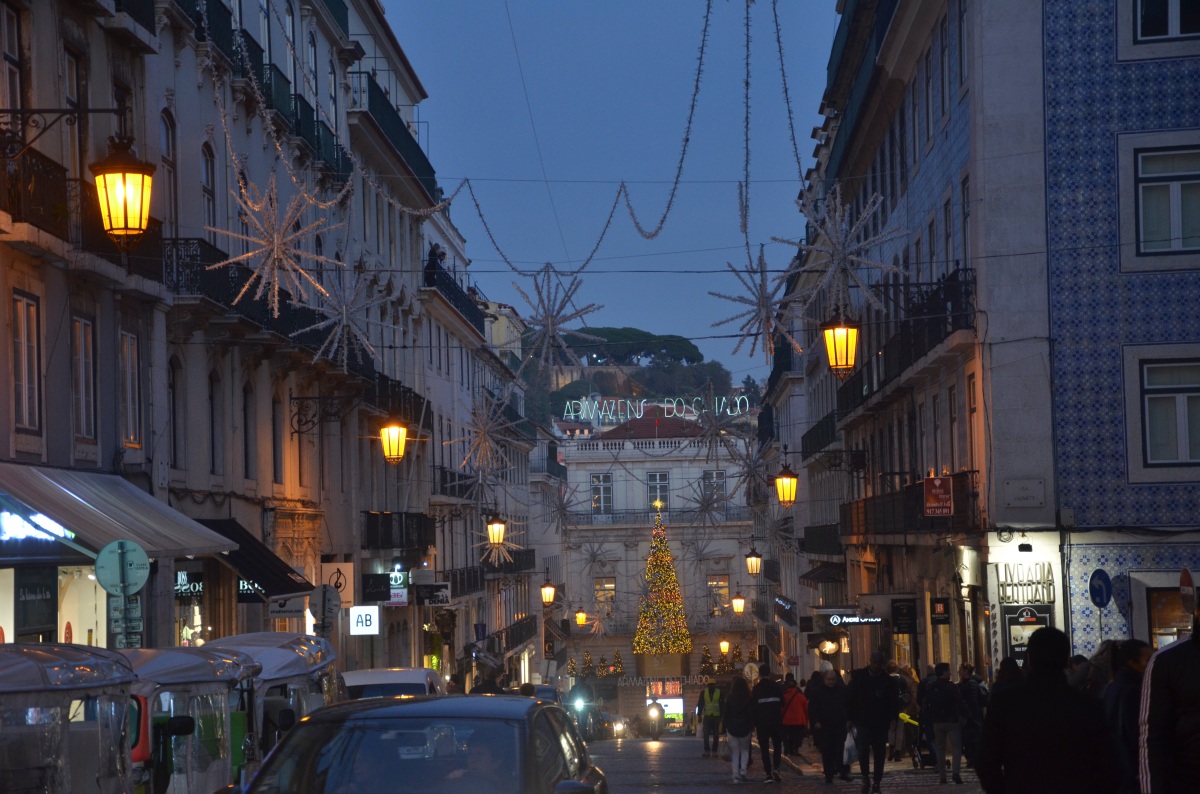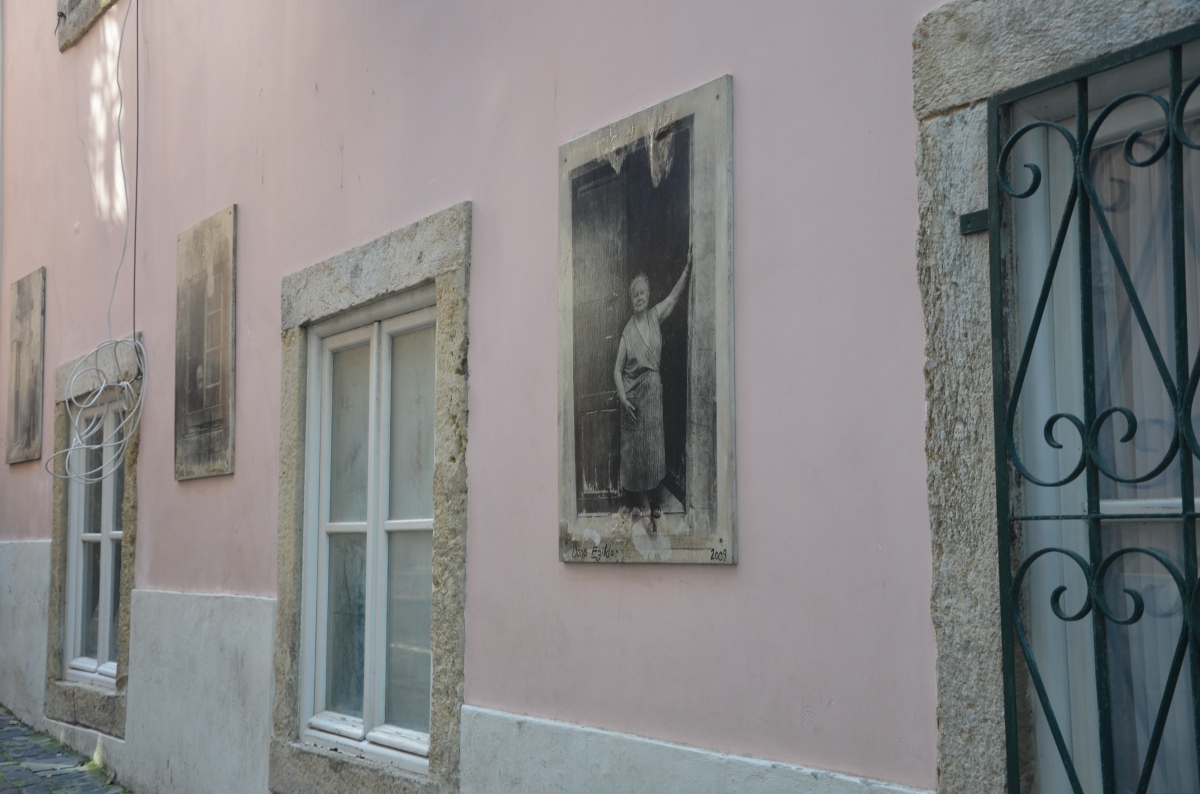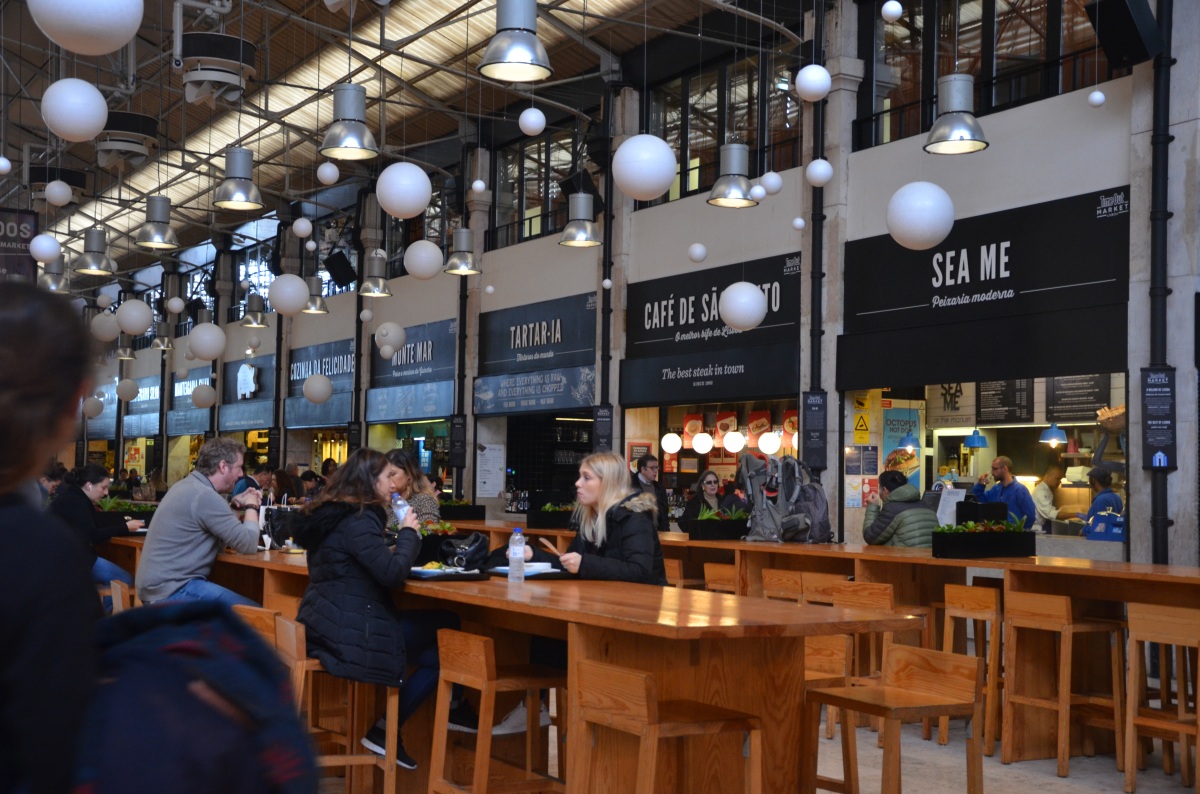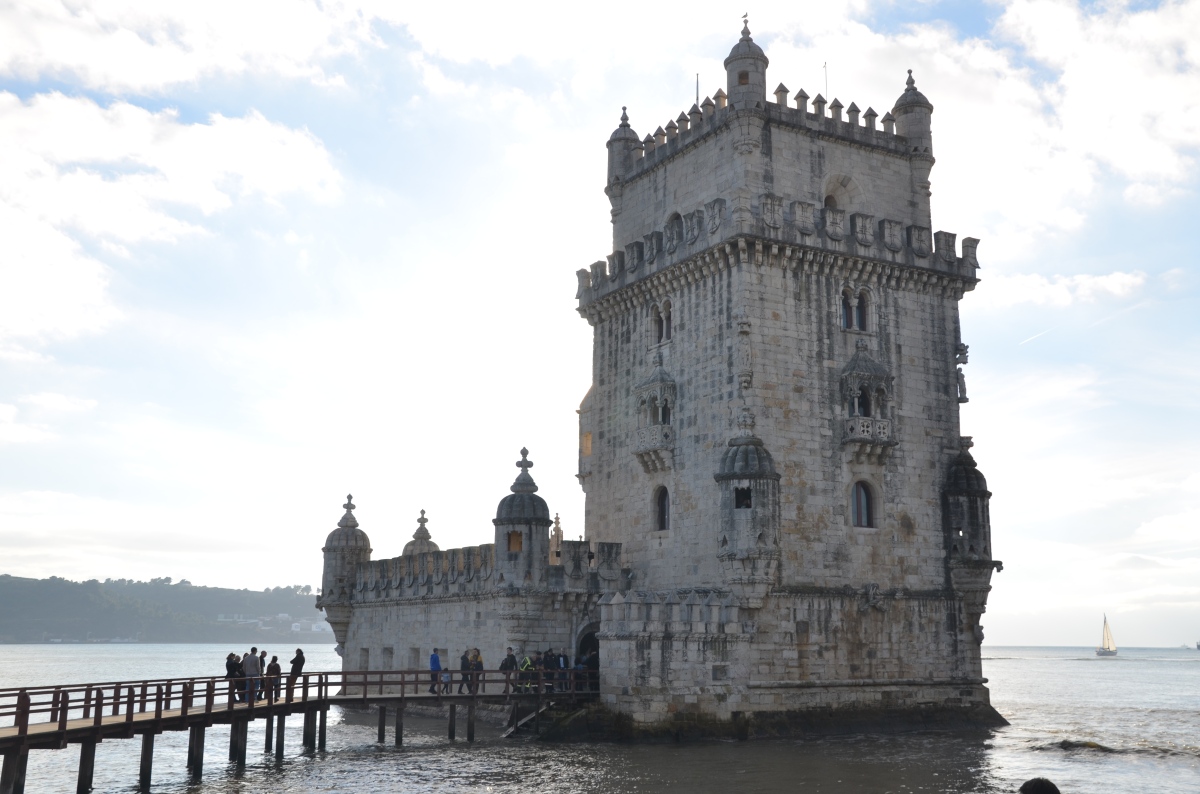We loved Lisbon, Portugal! In other reviews and write-ups about Portugal, it is often lumped with Spain, which is selling it short. It stands alone. Lisbon was economical, the weather in December was mild (60Fs) and sunny, and the food was fantastic – seafood and pastries. Say no more! Many of the locals involved with tourism spoke either English or some Spanish. We loved it. Now, I want to go back and see more of the rest of Portugal.
Our highlights were where we stayed, Villa Baixa, our walking food tour with Kika and the dinners we ate each night with seafood and ending with a pastry. Here is a full itinerary starting with where we stayed and then a day by day listing of things to do and places to eat.
There are five central regions where people generally stay. There are two hills of the older city called Barro Alto on one side and Alfama on the other with a flatter area of city streets called Baixa in the middle. There is a trendy area of shopping and eating called Chiado near Baixa which is in the hilly section as you head towards Barro Alto, also. We stayed in Baixa at a central, lovely clean apartment in a great location, with nice views of the castle out of our balcony at Villa Baixa. Our apartment, 5B was on the fifth floor, so the elevator was a plus. We liked being central, on flat streets with a variety of transportation around and easy to find at night.
Our apartment on the fifth floor of the building had a super view of the castle, Castelo de St Jorge. From the small balcony we could see down one of the main Baixa streets to the sea and in the other direction to one of the main plazas, Plac du Figueria. Although our cross street was busy (and lead to the well-known Elevator de Santa Justa), the bedroom was not noisy for sleep. The location was excellent with easy access into all of the main tourist areas of the old parts of the city. We also booked airport rides to and from the apartment (in advance), which was very convenient.
More Details on our Housing … In terms of feedback, having a few condiments, such as salt and pepper and also a map of Lisbon in the apartment would have been nice. Also, the woman who checked us in upon our arrival did not provide any information about the apartment. We did not understand how the lights worked with our key card, how to turn on the stove-top, how to open the safe (which was locked closed), and how best to operate the heating units. We arrived tired at night and she left shortly after we arrived. It would have been friendly and helpful to either have information about those special items in the apartment, to walk us to our apartment and tell us about those items or to tell us about them at the front desk upon check-in. But, the cleanliness of our apartment, the openness and light, having a secure front door with a mostly manned front desk and the central location made up for these issues. We would rent this apartment again.
Joao do Grao – The first night we arrived in Lisbon, we ate dinner close to our rental apartment at Joao do Grao. This restaurant is one of the ones “on the strip” near one of the big Plazas where the men with menus yell at you to eat at their place. We chose the one with the coziest inside decor and for which the man was not yelling, however, we did not know it was because they were closing soon. We thought the restaurants in Lisbon were open late. This place, however, only serves until 10 pm, at least on this Monday night.
As soon as we sat down, the wait staff immediately put out many spreads, bread and appetizers on our table. Beware, in Lisbon you will be charged for each of these! Only select the ones you want and send the rest back. We chose the fish pate and the bread and declined the others. We shared a seafood rice dish and a citron sorbet. The rice dish was filling and good, a bit generic, but hit the spot. The dessert was good. All in all, compared to the other dinners we had in Lisbon this was the least good, but it hit the spot for our first night.
Our second day in Lisbon, I had reserved a food and walking tour with Culinary Backstreets. We lucked out; this was fantastic! At 10:30 am, we met Kika and four other people at Mercado du Riberia, now called the Time Out Market.

From 10:30 am until around 3 pm, she walked around the market, Baixa and Chaido areas of Lisbon with us, introducing us to ceramic shops and traditional foods of Lisbon and telling us about where things came from, how things were made and which shops and restaurants were traditional and good. It was charming, informative and fun.
After the market, we started at this plaza to try some of the traditional ginja (cherry) liquor from the red corner kiosk to warm us up.

My daughter and I enjoyed the walking, the food, the company and all of the information. The highlights of the tour for me were the view from the Nun’s Cantina, Vicente’s for lunch, Landau’s chocolate cake and Mantiegeria for traditional pastries – my daughter and I went back every night for one! We watched every step of their process and then ate two warm traditional pastries sprinkled with cinnamon.

I loved the traditional Portuguese shops as well. We enjoyed Kika immensely and we liked our tour members so much we met up with them again later in the week for more. It was a great introduction to the city. We took every one of Kika’s recommendations for dinner through-out our week in Lisbon and each restaurant was great.
That night, we ate at A Cevicheria – This was one of my favorite dinners while in Lisbon. It has a low-key vibe, but lovely seafood dishes, many with quinoa. I loved the seaweed butter with squid ink crackers to start. Each dish had an interesting detail. I liked the green gazpacho with a scallop, Portuguese ceviche, fish with quinoa and octopus foam and dessert of citron quinoa. Surprising and fun. Our wait staff was attentive and helpful. I appreciated the multi-lingual menu. The options were fresh and good. There is just a line of tables in this corridor style restaurant and it filled up quickly. So we ate at 7 pm and were glad to be early.
Arone – The pastries at Arone in Chaido are all made from various sweetened vegetable fillings with nut paste, such as sweet potato with almond, pumpkin with almond, spaghetti squash, etc. It may sound quirky, but the combinations are good and with crunchy meringue or toffee. They are sweet and exciting. We ate here twice after dinner for dessert and enjoyed trying a number of their prize winning pastries.
Gelato – While in Lisbon, we tried many of the various gelato places, all along or around Rua Garrett. We tried Grom, which had nice fruit and dark chocolate flavors. I liked Persimmon there. We also tried Santini both at the market and in Chaido. My favorite gelato were Santini and Sorbettini in Chaido off the main square. Santini used Valhonna for their dark Chocolate and it was very good. Their fruit flavors seemed to be just a bit denser and more flavorful than the others.
We loved our Baixa/Chaido neighborhood near the Santa Justa Elevator and would recommend it as an area to stay. We would have a lovely early dinner each night and then walk back to our active and lively area along Rua Garrett. There was shopping and pastry shops open until 10 or up to 12 Midnight around us. We would have a pastry or gelato and walk around. It was active near us, but our apartment was quiet for sleep. A perfect combination!

On our second full day in Lisbon, we had the full day to ourselves. We walked up from Santa Justa to the Castle, stumbling on a good route up (from Baixa marked with brown signs to the castle) which took us past historic graffiti about Fado and along a road with lovely look-outs towards the Sea. We stopped at a few tile shops we liked before we arrived at the castle walls.
Castelo de St. Jorge – There is an entrance fee, but it is worthwhile to be able to walk along the outer wall of the castle and see Lisbon from this viewpoint.

The esplanade is wide, filled with trees and on a clear day it provides a lovely view of the city. You can also enter the various layers of the old castle walls from here. There is an inner garden with peacocks, which is quite pretty. Then there are two to three layers of inner courtyards and walls of castle.

The castle itself is empty, but it is interesting to walk into it. We did not enter any of the inner buildings or museums, but the entrance fee allows you to.
We walked out of the castle and wandered some of the small streets outside the castle to get a sense for what the upper city was like before cars.
The streets around the castle and Alfama are small and quaint.

There is a very beautiful look-out at the top of one of the streets walking down from the castle towards Alfama. At this pillared viewpoint called Santa Luzia, which is ideal for photos, you can look out to Alfama and the Sea.

Further down the street is the Cathedral Sé. It’s particularly beautiful to be in this viewpoint in the afternoon or at sunset.
From there, you can walk down towards the Cathedral Sé. We loved to walk into the Cathedral and get a sense for the city in older times. It is not the city’s most beautiful church, but it is one of the largest.
Cantinko de Sé – We ate lunch at a restaurant down from Sé near a tram stop so that we could catch the #12 tram after we ate. This was not great food, but we had paella. Our guide later chided us for eating Spanish food in Portugal. But, my black squid rice hit the spot. We tried three pastries afterwards and they were not great. After walking all day, though it was good to sit down and get warm.
Tram 12 – Riding the trams in Lisbon is great fun. The central city trams are the best. It is easiest to catch these at the start of their run, at the start of a day or at meal times when they are not as crowded. Tram 12 runs a loop starting at Plac du Figeria, up the hill of Alfama, back down through the main street of Baixa and back to the Plaza again.

It is fun to just run the whole loop and see Alfama. It takes about 20 minutes. We got on in the Plaza and rode the tram the whole route for 2.90 euro each. My favorite part of the ride was that a number of older Portuguese women got on the tram after the end of their working day. They obviously knew each other and the driver, who was a young woman. They all greeted each other and chatted. The driver dropped each off at their home along the route. It was very sweet. Tram #28 runs east/west across the city and goes past many of the sight-seeing spots in the city. It gets very crowded. You can purchase 24-hour public transport ticket, which includes the metro and all tram and bus services for 6.30 euros, but they can only be purchased in metro stations.
Tapisco – We ate dinner at Tapisco for our third dinner out and it was my favorite. It is also at the top of Dom Pedro in Barro Alto near some of the other restaurants. It is a long corridor style restaurant which fills up as it gets later in the evening, so we were glad to arrive around 7 pm for dinner and not have a problem getting a table for two. We had a wonderful dinner. They served traditional, but very elegant and special food. I had the salted cod with potatoes and it was perfect. Fantastic service and food. We loved it.
Our third full day, we had another tour with Kika. Francesca Menano or Kika, is a tour guide with Culinary Backstreets, but is also starting to do private tours on her own. We liked her so much from our first official day and food tour (see above), we hired her on her own with the four other people we met before, for a tour of her choice. It was wonderful.
Fado with Kika – Kika met us north central and introduced us to Fado music and how it started in Lisbon. In the area known as Mouraria, which is between Baxia and Alfama, the Fado music of Lisbon and Portugal is supposed to have been born.

There are a number of famous Fado singers from this area. There are some well know female singers who started here who were very poor and probably prostitutes. The music was popular with the poor people of this area, but these singers also brought it to the people of Lisbon. One singer, Mariza was popular world-wide.
There are beautiful photographs which have been transferred to the walls of buildings in the streets of this area. As we walked to the Alfama, the photo transfer art on the walls depicts some of these singers and some of the neighborhood people of modern times, also. We walked through some small back streets and saw the buildings and places where Fado started. It was very special, since we would never have understood it or found it on our own.

From Mouaria, Kika lead us up a set of streets labeled with brown signs from Plac du Figueria to the Castle along which you can see the murals about Fado to the Castle walls. There are lovely shops and places to eat. There are also great views out to the water. Kika is an expert about the history of Lisbon and all the best places to eat, shop and to get the best views. She is indeed an expert on the city. We loved walking and eating with her.
Miss Can – For lunch, we visited Miss Can, which sells canned fish. I know, not everyone thinks they will like canned fish. But, we all went in and the charming owner (who is a friend of Kika’s) opened four to six cans of his fish caught and canned in the north part of Portugal. He also had a number of salads and we all tried different things: salted cod with garlic, tuna with rosemary, stuffed squid, mackerel in spicy sauce, tomato salad, etc. We also had special Portuguese “green wine” Vino Verde, which is like a champagne without bubbles in taste. Everything was wonderful. We all bought canned fish to bring home. I recommend trying it.

Ramiro – Our third evening, dinner four, we went to the famous Ceviche Ramiro for seafood. We knew we had to go early and that we would just have plates full of seafood, but we didn’t know what else to expect. We went at 6 pm. There was no wait and tables were still open. When we left at 7:30 pm, this was not the case. It was a wonderful experience. It is busy and loud with long tables for multiple parties at a table. The male wait staff divide up the parties at the tables. You order various plates of seafood and the food comes in the order it is ready. We had shrimp in garlic and butter, a steak sandwich, the crab, steamed clams and a plate of buttered toast. Everything was excellent. It was “just” seafood without any extras. No salads, no side dishes, no veggies, no desserts, unless you order them ala cart. If you love seafood done multiple ways, this is your place. No frills, nothing fancy and it was affordable.
We started our fourth day at the Time Out Market for a brunch. We wanted to get there before the crowds, so we arrived around 10:30 or 11 am. It was perfect. We were hungry, the shops were open and not busy, and the tables were mostly empty. By the time we left at 12 Noon, it was packed with very few free seats. We got a steak sandwich and octopus salad at the Michelin star restaurant Sa Pessoaa. We got ham, cheese and melon from Manteigeria Jose Oliveria and Sorbetto from Santini. It was a wonderful brunch. By 12 N there was nowhere to sit in the market. The market is a great place to try small plates from some of the great chefs and restaurants with a Michelin star level in the city without having to walk all over the city and without having to pay for a large meal. It is very popular.

From Time Out, we crossed the street and caught the Tram #15 and rode it out of town about five miles to Belem. We got off near the small town and to see the Belem Monastery. You can view the lovely outside with all the carvings. If you want to go inside and see the chapel, you can see it free of charge. If you want to see the cloisters, you need a ticket. You walk further down to the art museum and you can purchase a ticket for the museum and the cloisters and see the sections you want to see. The ticket machines are automated, but there is usually a person there also to help. Unfortunately, the day we visited there were large school groups there which were very noisy and it was not very pleasant. It was still lovely to see the cloisters, but we walked through quickly.
Belem Tower – We walked further down the sea walk to see the famous sculpture of the people of Lisbon on the sea going vessel at the port and then to the Tower of Belem.

The Tower is from the 15th Century and is said to welcome the sailors coming back home into port to Lisbon.

It is wonderful to be able to walk around it and view it from many sides. You can also enter the tower and look out of its windows. We just viewed it from the steps and from the wall to its side. It is an icon of Lisbon.
Belem is famous for introducing the pastries of Lisbon. When Portugal became a dictatorship, the monks of the monastery were not allowed to worship any longer. They needed to earn money, so they started to sell some of the foods they had been preparing for themselves in the monastery. One of the recipes was for their cream pastries, Pastel du Nata or also called Pasties de Natal. These became very popular and are now one of the symbols of Lisbon. The original recipe is still a guarded secret, although other bakeries also make similar pastries. The Pasteis de Belem are available from the restaurant with blue awnings near the Monastery. There is usually a long line to purchase the pastries from the shop, but if you want to eat inside, you can go around this line and go inside to sit down. There may still be a line inside for seating, but it is usually much shorter. You can order from the menu and have tea and coffee. It is quite lovely to sit inside, also. The pastries of Belem were our favorite.
That night, we ate at the fanciest restaurant in Lisbon, Bairro do Avillez. We had made a reservation for 7 pm to make sure we had a table. There are three sections to the restaurant and we were in the back. Interestingly, although it had been hyped and the prices were much higher than other places we had eaten, the food was not better. The desserts were much more elaborate and were the best we ate anywhere, but the entrees were disappointing for the price. My daughter tried a traditional stew with pureed bread and it was not as tasty as she had hoped and was not served with anything to eat it with, such as rice or potatoes.
After dinner, we walked up towards Dom Pedro and went to Cafe Luso for Fado music. We had to purchase a minimum of food or drink, but the Fado was playing from 10 pm to 2 am. There were four Fado singers, three women and one man. We really loved one of the female singers and enjoyed her solo set the most. It was a real treat to get to hear the traditional Portuguese Fado music in a beautiful setting with the ceramic bricked ceiling of an older building.
Our last full day in Lisbon, we decided to do more shopping and see anything we might have missed walking through as locals might before the holidays. So, we:
- purchased some gifts in gold at O Bau.
- had lunch at the typical Portuguese “fast food” café, A Padaria in Baxia.
- purchased textiles and woven wool at Chicoracao.

- purchased a few gifts which were hand made by local artists at A Arte da Terra gallery, which is housed in a beautiful old building worth seeing itself.
Our last dinner in town, we ate at Cafe Fabulas in Chaido. It has a small non-descript front door leading through many hallways to a large outdoor patio and lovely lower ground seating with a tiled traditional roof. The food was simple and lovely. I had a traditional cod with egg and potato set into a quiche sort of pie and my daughter had shrimp. It was filling and good. We had our last Manteigeria pastries in the main Chiado square off Rua Garrett.
We loved Lisbon. It was affordable. The people were open and friendly. The weather in December was warm (each day was sunny and in the 60s). The city has many interesting areas and things to see and do. Most importantly, the food was fantastic. I would love to go back and also see other areas of Portugal. Portugal needs to promote itself more – it is such a wonderful destination!

